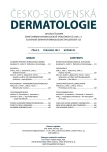Retinoids in Dermatology
Authors:
N. Benáková 1,2; V. Vašků 3
Authors‘ workplace:
Dermatovenerologická klinika 1. LF UK a VFN Praha
přednosta prof. MUDr. Jiří Štork, CSc.
1; Dermato-alergologická ordinace ImmunoFlow Praha
vedoucí pracoviště MUDr. Matrin Fuchs
2; Dermatovenerologická klinika LF MU Brno
přednosta prof. MUDr. Vladimír Vašků, CSc.
3
Published in:
Čes-slov Derm, 92, 2017, No. 3, p. 111-122
Category:
Reviews (Continuing Medical Education)
Overview
The authors discuss the history of the development and classification of retinoids, their pharmacodynamic properties, including the biological potential for the treatment. The overview discusses the pharmacological and clinical characteristics of topical and systemic retinoids, their availability and current conditions of reimbursement in the Czech Republic. The main part is the use of retinoids in practice, more in detail the use of three systemic retinoids – acitretin, bexarotene and isotretinoin. The tables show the standard indications as well as the less common possibilities of their use, contraindications, dosing and current recommendations for clinical and laboratory examinations before and during treatment and follow-up. Detailed side effects and measures for their prevention, alleviation and early recognition are discussed. The advantages of retinoids such as the absence of immunosuppression, the possibility of combination therapy, the minimal drug interactions, and a generally good safety profile that outweight the potential risks that allow their use for long-term maintenance therapy, are also emphasized.
Key words:
retinoids – systemic therapy – practical use and perspective in dermatology
Sources
1. BENÁKOVÁ, N., ETTLER, K., ŠTORK, J., VAŠKŮ, V.: Psoriáza nejen pro praxi. Triton: Praha, 2007, s. 173–193.
2. BIENOVÁ, M., KUČEROVÁ, R.: Retinoidy v dermatologii. Dermatol. praxi 2008, 2, s. 171–174.
3. BOLOGNIA, J. L., JORIZZO, J. L., SCHAFFER, J. V.: Dermatology. Elseviere: 2013, Third Edition, p. 2089–2103.
4. BUČKOVÁ, H. et al.: Léčba psoriázy u dětí. Čs. Derm., 2013, 2, s. 59–71.
5. GOLLNICK, H. P.: Retinoids for the future: Oral retinoids – efficacy and toxicity in psoriasis. Br. J. Dermatol., 1996, Suppl. 135, p. 6–17.
6. GOLLNICK, H. P., BETTOLI, V., LAMBERT, J. et al. A consenus-based practical and daily guide for treatment of acne. JEADV, 2016, 30, p. 1480–1490.
7. GRUPPER, Ch., BERETTI, B.: Retinoid combinations. In: Roenigk, H. H, Maibach, H. I.: Psoriasis. 2. ed., New York 1991, p. 775–782.
8. HALVERSATM, C. P., ZEICHNER, J., LEBWOHL, M.: Lack of signifikant skeletal changes after long-term, low-dose retinoid therapy: case report and review of literature. J. Cutan. Med. Surg., 2006, 10, p. 291–299.
9. HSU, S., PAPP, K. A., LEBWOHL, M. G. et al. Consensus guidelines for the management of plaque psoriasis. Arch. Dermatol., 2012, 148, p. 95–102.
10. CHUNG, C. G., POLIGONE, B. Cutaneous T cell Lymphoma: an Update on Pathogenesis and Systemic Therapy. Curr. Hematol. Malig. Rep., 2015, 10, p. 468–476.
11. IEST, J., BOER, J. Combined treatment of psoriasis with acitretin and UVB phototherapy compared with acitretin alone and UVB phototherapy alone. Br. J. Dermatol., 1989, 120, p. 665–670.
12. LYNDE, CH. W., KRAFT, J. N., LYNDE, C. B. Acitretin revisited. Skin Therapy Letter, 2011, 16, p. 3.
13. MARQUELING, A. L., CORDOR, K. M. Systemic treatment for severe pediatric psoriasis. Dermatol. Clin., 2013, 31, p. 267–288.
14. MENÉNDEZ-GUTIÁRREZ, M. P., RICOTE, M. The multi-faceted role of retinoid X receptor in bone remodeling. Cell. Mol. Life Sci., DOI 10.1007/s00018-017-2458-4.
15. MENTER, A., KORMAN, N. J., ELMET, C. A. et al. Guidelines of care for the management and treatment of psoriasis with traditional systemic agents. JAAD, 2009, 61, p. 451–485.
16. NAST, A., GISONDI, P., ORMEROD, A. D. et al. S3 – Guidelines on the systemic treatment of psoriasis vulgaris – update 2015. JEADV, 2015, 29, p. 2277–2294.
17. NAST, A., DRÉNO, B., BETTOLI, V. et al. European evidence-based (S3) guideline for treatment of acne – update 2016. JEADV, 2016, 30, p. 1261–1268.
18. ORMEROD, A. D., CAMPALANI, E., GOODFIELD, M. J. D.: BAD guidelines on the efficacy and use of acitretin in dermatology. Br. J. Dermatol., 2010, 162, p. 952–963.
19. PANCHAL, M. R., SCARISBRICK, J. J. The utility of bexarotene in mycosis fungoides and Sézary syndrome. Onco Targets and Therapy, 2015, 8, p. 367–373.
20. PATHIRANA, D., ORMEROD, A. D., SAIAG, P. et al. European S3-guidelines on the systemic treatment of psoriasis vulgaris. JEADV, 2009, 23, p. 1–70.
21. PAUL, C., GALLINI, A., MAZA, A. et al. EBM recommendations on conventional systemic treatments in psoriasis. JEADV, 2011, 25, Suppl. 2, S 2–11.
22. QU, L., TANG, X. Bexarotene: a promising anticancer agent. Cancer. Chemother. Pharmacol., 2010, 65, p. 201–205.
23. SARDANA, K., SEHGAL, V. N. Retinoids: Fascinating Up-and-Coming Scenario. J. Dermatol., 2003, 30, p. 335–380.
24. SAURAT, J. H.: RXR – ligands: their evolving clinical potential. Přednáška na sympoziu Oral retinoids – dermatology and beyond. 12. kongres EADV, Barcelona 2003.
25. SBIDIAN, E., MAZA, A., MONTAUDIÉ, H. et al. Efficacy and safety of oral retinoids in different psoriasis subtypes: a systematic literature review. JEADV, 2011, 25, Suppl. 2, S 28–33.
26. ŠTORK, J. et al. Dermatovenerologie. Galén 2007, s. 463.
27. Van DOOREN-GREEBE, R. J., LEMMENS, J. A., De BOO, T. et al. Prolonged treatment with oral retinoids in adults: no influence on the frequency and severity of spinal abnormities. Br. J. Dermatol., 1996, 134, 71–76.
28. ZINZANI, P. L., BONTHAPALLY, V., HUEBNER, D. et al. Panoptic clinical review of the current and future treatment of relapsed/refractory T-cell lymphomas: Cutaneous T-cell lymphomas. Critical Reviews in Oncology/Hematology, 2016, 99, p. 228–240.
29. Souhrn údajů o přípravku (SPC 2017) Neotigason, Curacné, Aknemycin, Targretin. www.sukl.cz
Labels
Dermatology & STDs Paediatric dermatology & STDsArticle was published in
Czech-Slovak Dermatology

2017 Issue 3
Most read in this issue
- Retinoids in Dermatology
- Nodular Fasciitis
- Psychogenic Dermatoses – the Description of 4 Cases
- Sweet Syndrome in a Patient with Myelodysplastic Syndrome – Case Report
